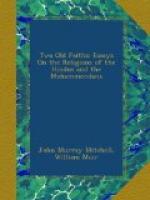[Sidenote: Its creed.] In the Creed of the New Dispensation the name of Christ does not occur. The articles were as follows:
a. One God, one Scripture, one Church. b. Eternal progress of the soul. c. Communion of prophets and saints. d. Fatherhood and motherhood of God. e. Brotherhood of man and sisterhood of woman. f. Harmony of knowledge and holiness, love and work, yoga and asceticism in their highest development. g. Loyalty to sovereign.
[Sidenote: Omission of Christ’s name.] The omission of Christ’s name is the more remarkable because Mr. Sen spoke much of him in his public lectures. He had said in May, 1879, “None but Jesus, none but Jesus, none but Jesus ever deserved this precious diadem, India; and Jesus shall have it.” But he clearly indicated that the Christ he sought was an Indian Christ; one who was “a Hindu in faith,” and who would help the Hindus to “realize their national idea of a yogi” (ascetic).
[Sidenote: “Motherhood of God.”] Let it be noted that, from the beginning of his career, Mr. Sen had spoken earnestly of the fatherhood of God and the brotherhood of man—though, these great conceptions are not of Hindu origin. It is difficult to see why, in later days, he insisted so much on the “motherhood of God.” Perhaps it was a repetition—he probably would have called it an exaltation—of the old Hindu idea, prevalent especially among the worshipers of Siva, that there is a female counterpart—a Sakti—of every divinity. Or, possibly, it may have been to conciliate the worshipers of Durga and Kali, those great goddesses of Bengal.
[Sidenote: Public proclamation said to be from God.] A public proclamation was soon issued, purporting to be from God himself, as India’s mother. The whole thing was very startling; many, even of Keshub’s friends, declared it blasphemous. Next, in the “Flag Ceremony,” the flag or banner of the New Dispensation received a homage scarcely distinguishable from worship. Then—as if in strict imitation of the ancient adoration of Agni, or Fire—a pile of wood was lighted, clarified butter poured on it, and prayers addressed to it, ending thus—“O, brilliant Fire! in thee we behold our resplendent Lord.” This was, at least, symbolism run wild; and every one, except those who were prepared to follow their leader to all lengths, saw that in a land like India, wedded to idolatry, it was fearfully perilous.
[Sidenote: “Apostolic Durbar.”] In March, 1881, Mr. Sen and his friends introduced celebrations which, to Christian minds, seemed a distressing caricature of the Christian sacraments. Other institutions followed; an Apostolic Durbar (Court of Apostles), for instance, was established. There was no end to Mr. Sen’s inventiveness.
In a public lecture delivered in January, 1883, on “Asia’s message to Europe,” he elaborately expounded the idea that all the great religions are of Asiatic origin, and that all of them are true, and that the one thing required to constitute the faith of the future—the religion of humanity—is the blending of all these varied Oriental systems into one.




